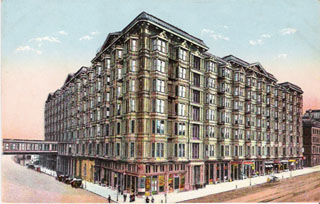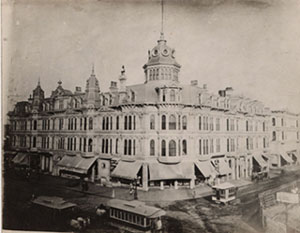|
A MARRIAGE OF GIANTS
 Very few public buildings in the world have struck travelers with greater
astonishment than the Palace Hotel of San Francisco. This seems a bold assertion
to make, but it is nevertheless true. The pyramids and other marvels of
antiquity, the great castles of the middle ages, and the magnificent abodes of
modern royalty, are very wonderful and awe inspiring, no doubt; but they have
been talked about so much and described so often, that the traveler not only
knows what to expect before seeing them, but often finds that his anticipations
were vastly finer than the reality. Now, with regard to the Palace Hotel this is
not the case. It, too, has been talked about a great deal—so much, in fact, that
there is today hardly any one in the East or in Europe who has not heard of “the
biggest hotel in the world.” But people instinctively form their ideas by
comparison, and when the traveler has anticipated seeing in the Palace a larger
hotel than he has ever seen before, his imagination is satisfied. He is not
prepared to enter a caravansary beside whose mighty proportions all others in
the world are dwarfed into insignificance, and in comparison with whose
luxurious appointments and modern improvements all others seem shabby and
old-fashioned. Hence it comes about that the guest who for the first time
experiences the hospitality of the Palace, must be a very unimpressionable
creature if he is not surprised into a state of astonished admiration from which
he does not find it easy to recover. Very few public buildings in the world have struck travelers with greater
astonishment than the Palace Hotel of San Francisco. This seems a bold assertion
to make, but it is nevertheless true. The pyramids and other marvels of
antiquity, the great castles of the middle ages, and the magnificent abodes of
modern royalty, are very wonderful and awe inspiring, no doubt; but they have
been talked about so much and described so often, that the traveler not only
knows what to expect before seeing them, but often finds that his anticipations
were vastly finer than the reality. Now, with regard to the Palace Hotel this is
not the case. It, too, has been talked about a great deal—so much, in fact, that
there is today hardly any one in the East or in Europe who has not heard of “the
biggest hotel in the world.” But people instinctively form their ideas by
comparison, and when the traveler has anticipated seeing in the Palace a larger
hotel than he has ever seen before, his imagination is satisfied. He is not
prepared to enter a caravansary beside whose mighty proportions all others in
the world are dwarfed into insignificance, and in comparison with whose
luxurious appointments and modern improvements all others seem shabby and
old-fashioned. Hence it comes about that the guest who for the first time
experiences the hospitality of the Palace, must be a very unimpressionable
creature if he is not surprised into a state of astonished admiration from which
he does not find it easy to recover.
 When a deep basement covering two and a quarter acres underlies seven (and
through a considerable portion eight) lofty stories, one would think that surely
the daring enterprise of the builder and owner of such a colossal structure had
reached its limit. Such, however, is not the case with Senator William Sharon,
the designer and proprietor of the Palace. Stupendous as were the original
proportions of the hotel, they are now vastly enlarged by its elegant neighbor,
the “Grand,” being joined to it by a bridge crossing New Montgomery Street. The
Grand is itself not only a very large hotel, but is acknowledged to be one of
the handsomest buildings, architecturally, in San Francisco. To take a fanciful
view of the event it looks as if the giant Palace had fallen in love with his
beautiful neighbor, and, after many years of wooing, had persuaded her to marry
him. And this idea is strengthened by the fact that the Grand has lately been
magnificently refurnished throughout, nearly all the old furniture, as our
readers will remember, have been sold at auction, so that the bride goes to the
groom equipped with a splendid trousseau. When a deep basement covering two and a quarter acres underlies seven (and
through a considerable portion eight) lofty stories, one would think that surely
the daring enterprise of the builder and owner of such a colossal structure had
reached its limit. Such, however, is not the case with Senator William Sharon,
the designer and proprietor of the Palace. Stupendous as were the original
proportions of the hotel, they are now vastly enlarged by its elegant neighbor,
the “Grand,” being joined to it by a bridge crossing New Montgomery Street. The
Grand is itself not only a very large hotel, but is acknowledged to be one of
the handsomest buildings, architecturally, in San Francisco. To take a fanciful
view of the event it looks as if the giant Palace had fallen in love with his
beautiful neighbor, and, after many years of wooing, had persuaded her to marry
him. And this idea is strengthened by the fact that the Grand has lately been
magnificently refurnished throughout, nearly all the old furniture, as our
readers will remember, have been sold at auction, so that the bride goes to the
groom equipped with a splendid trousseau.
The bridge which forms the matrimonial bond between this Brobdignagian couple is
in itself a structure well worthy of description. In appearance, both from
within and without, it is singularly light and elegant. Its architect, Mr. J. P.
Gaynor, showed his usual skill and irreproachable taste in producing this
effect, for it spans a broad and beautiful street, and anything at all heavy or
ugly to such a position would have marred one of our handsomest thoroughfares.
But, with all its graceful and airy appearance, the bridge is of very great
strength, and here, again, the architect knew what he was about, for the strain
on it will necessarily be considerable, and its breaking down would involve most
disastrous results. Mr. Gaynor’s plans have been most ably and thoroughly
followed by Messrs. Terrill and Slaven, the contractors, in whose hands the
carrying out of the entire work was placed. Nor was it a trifling undertaking,
for the link between the two hotels has been built after the same fine fashion
that characterizes the edifices it connects. Its length is 72 feet, its breadth
10 feet, it spans the road at a height of 23 feet, from floor to ceiling it is
nearly as much more, while from the street to the top of the ridge of delicate
iron lacework surmounting it is a distance of 50 feet. The whole is framed in
the best possible manner, and profusely glazed with heavy plate glass till it
looks like an aerial conservatory. The interior is richly painted and carpeted.
The total cost was between $4,000 and $5,000.
Among the many advantages which will be gained by this connection of the two
hotels, one ought to be especially mentioned. The guests of both will now all
dine in the magnificent dining room of the Palace, or in the renowned restaurant
which is an adjunct to that hotel. Consequently, the ranges have all been
removed from the Grand. Now, it is well known to those familiar with such
matters that the greatest danger of fire in hotel exists in its kitchens. So
necessarily intense and constant is the heat in the ranges that they “burn out”
very rapidly, and no matter how close the watch kept over them, they can never
be said to be absolutely safe unless the kitchen department is fire proof. The
kitchens of the Palace are perfectly fire proof, and there henceforward all the
cooking will be done.
Although the two hotels are thus practically converted into one, it will readily
be seen that the management of such an enormous establishment would overtax the
energies of an single human being, no matter what his ability and energy. The
Grand will, therefore, continue to be ably managed by Mr. S. F. Thorn, than whom
no more genial and agreeable gentleman ever played the pleasant role of
Boniface. The Palace, in like manner, will remain under the superintendence of
Mr. A. D. Sharon, nephew of the proprietor, Senator Sharon, and lessee of the
building. As a hotel manager, Mr. Sharon is unquestionably the pink of
perfection. While gentlemanly, affable and courteous to all, he at the same time
possesses an extraordinary amount of executive ability. He has, however, the
rare gift of performing his arduous duties without apparent effort. No one ever
sees him excited or irritable. To look at him, or speak to him, you would think
him a gentleman of absolute leisure, utterly free from all care or
responsibility. Yet no detail escapes his eye, and every requirement of the
hotel commands his personal attention. It must not be forgotten, however, that
Mr. Sharon has the advantage of an invaluable aid and lieutenant in the person
of Mr. George H. Smith, the chief clerk. This gentleman is in many ways a
remarkable man. Of all the qualifications required by one in his position, a
good memory for names and faces is, perhaps, the most important. Mr. Smith’s
memory is almost supernatural. A guest may stay at the Palace for a night and
not appear there again for years; but, for all that, the moment he re-enters the
office, Mr. Smith will great him by his name, converse with him on incidents
which occurred during his former visit, and make him feel as if he had come back
among friends, who had been thinking of nothing but him ever since he left San
Francisco. Mr. Smith is also one of the most accomplished linguists we have ever
known. Where the management is so excellent and efficient, it follows, as a
matter of course, that the army of subordinates is well disciplined and composed
of picked men. Consequently, every joint of the complicated machinery required
to run so vast an establishment works to perfection, and complaints are never
heard.
San Francisco is justly proud of her great hotel, the Palace, and has for many
years admired its beautiful neighbor, the Grand. The union of the two is,
therefore, an event of no slight importance, and one which we are sure will
prove as advantageous to the enterprising proprietor as to the public at large.
The combination presents a hotel on a scale of such immensity and grandeur that
henceforward it will be well worthwhile traveling from Europe to California for
the sole purpose of seeing it.
San Francisco News Letter and California Advertiser
August 28, 1880
Home
|